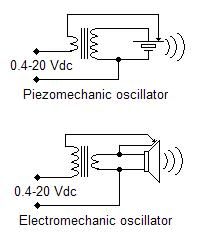Basic Circuit
POINT-CONTACT OSCILLATORS
Published:2013/5/7 21:24:00 Author:muriel | Keyword: POINT-CONTACT OSCILLATORS | From:SeekIC

The principle of operation of a car hooter has been applied to both a ceramic sounder and a loudspeaker. A break in the supply current is caused by the vibration of the ceramic sounder plate or the speaker membrane. You could implement similar circuits even without a transformer but the voltage range will be limited, there will be too much sparking at the contact point and pressure and position of the contact become critical. The transformer introduces a feedback mechanism thus eliminating or drastically reducing all mentioned negative effects. An output transformer is used in both circuits: one of the winding is normally 4 or 8Ω while the other is at a higher impedance. The larger plate of the piezomechanic oscillator goes to positive through the contact, typically an adjustable screw, and the transformer low impedance winding. To get the correct phase relationship you may need to reverse one of the windings. A similar transformer is used for the electromechanic oscillator with the low impedance winding connected to the speaker. Also in this case you may need to reverse one of the windings but first you must make sure that the speaker cone goes forward when the voltage is applied: reverse the speaker connections if necessary. A small copper strip is glued on the back of the speaker membrane with a screw placed in the speaker casing so that it just touches the copper strip.
Frequency of operation is from 1 to 1.5 KHz for both oscillators. The frequency for the electromechanic oscillator depends mainly on the speaker damping factor: best results are obtained with the speaker laid against a flat surface or sealing the front side with a wooden panel. Operation below 0.4-0.6V depends on the careful adjustment of the screw and mechanical precision of the assembly.
Reprinted Url Of This Article:
http://www.seekic.com/circuit_diagram/Basic_Circuit/POINT_CONTACT_OSCILLATORS.html
Print this Page | Comments | Reading(3)

Article Categories
power supply circuit
Amplifier Circuit
Basic Circuit
LED and Light Circuit
Sensor Circuit
Signal Processing
Electrical Equipment Circuit
Control Circuit
Remote Control Circuit
A/D-D/A Converter Circuit
Audio Circuit
Measuring and Test Circuit
Communication Circuit
Computer-Related Circuit
555 Circuit
Automotive Circuit
Repairing Circuit
Code: